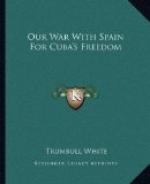The Virginius, although the most conspicuous, was not the only American victim of Spanish misgovernment in Cuba during the Ten Years’ war. In 1877 the three whaling vessels, Rising Sun, Ellen Rizpah, and Edward Lee, while pursuing their legitimate business under the American flag, outside of Cuban waters, were fired upon and detained for days, with circumstances of peculiar hardship and brutality. The United States government investigated the outrage with care, and demanded of Spain an indemnity of $19,500. The demand, however, was not enforced, and the sum of $10,000 was accepted as a compromise settlement.
CHAPTER XIV.
Operations op the ten years’ war.
The Two Wars Compared—The Havana Volunteers—The Slaughter at the Villaneuva Theater—The Court Martial of the Students—A Holiday in Havana—The Close of the War—The Treaty of Zanjon.
The reader who has watched closely the struggle in Cuba for the past three years need not be told that Spain has had every advantage in men, money, arms and ammunition. The same state of affairs existed during the Ten Years’ War. In fact, the inequality was even greater, for the Spanish army was then composed of experienced soldiers who were well fed, well clothed and paid regularly. In the present conflict many of them are boys who have been sent from home to make targets for insurgent bullets. They know comparatively nothing of military tactics, they have not been paid for months, and they lack food and clothing. The equipment of the insurgent forces in the former rebellion was even more limited than it has been in this one. While they did not experience serious difficulty in obtaining food, the implements of war in any quantities were beyond their reach. But the same spirit that gave courage to our American heroes in revolutionary times was in them, and for ten years they struggled bravely against overwhelming odds.
It is not possible to tell in detail of the monstrous cruelties practiced by the Spanish army during those years of carnage. Here is the testimony of one officer:
“We captured seventeen, thirteen of whom were shot outright; on dying they shouted, ’Hurrah for Free Cuba, hurrah for independence.’ A mulatto said, ‘Hurrah for Cespedes.’ On the following day we killed a Cuban officer and another man. Among the thirteen that we shot the first day we found three sons and their father. The father witnessed the execution of his sons without even changing color, and when his turn came he said he died for the independence of his country. On coming back we brought along with us three carts filled with women and children, the families of those we had shot, and they asked us to shoot them, because they would rather die than live among Spaniards.”
Another wrote:
“Not a single Cuban will remain in this island, because we shoot all that we find in the fields, on the farms and in every hovel. We do not leave a creature alive where we pass, be it man or animal. If we find cows we kill them, if horses, ditto, if hogs, ditto, men, women or children, ditto. As to the houses, we burn them. So every one receives his due, the men in balls, the animals in bayonet thrusts. The island will remain a desert.”




